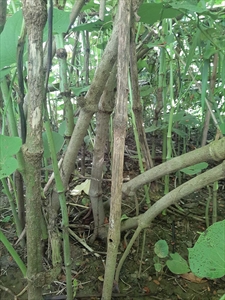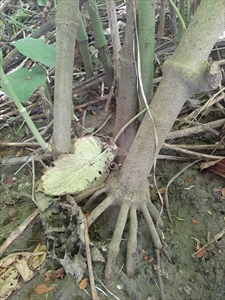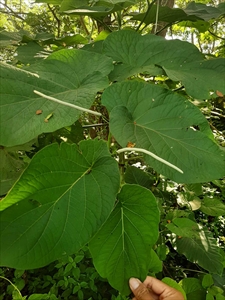- Worldwide distribution (except Africa). In Federated States of Micronesia, Fiji, French Polynesia, Samoa, Tonga, Vanuatu.
- Major invasive shrub, suckering rapidly, forming dense thickets in native forests, along waterways, plantations, pastures, food gardens. Difficult to control: all parts regrow rapidly. Competes with kava and presence lowers commodity value. Host of CMV, causing kava dieback.
- Small shrub, 1-2m, sometimes tree-like to 6m. Leaves, oval, 30cm long, with one lobe larger. Leaf stalks surrounding stem and winged. Flowers, small, pale green in long arching spikes, up to 25cn, opposite leaves.
- Spread: birds, bats, rodents, water; trade in kava.
- Biosecurity: chance of introduction high in kava consignments.
- Biocontrol: none.
- Cultural control: hand-weed removing all roots; or slash and collect all cuttings and burn. Clean machinery/vehicles.
- Chemical control: 2,4-D or imazapyr, applied to basal bark or cut stems.
Pacific Pests, Pathogens and Weeds - Online edition
Pacific Pests, Pathogens, Weeds & Pesticides
False kava (492)
False kava. It is also known as hoja santa (Spanish for 'sacred leaf'), spiked pepper, root beer plant.
Piper auritum. It is a member of the Piperaceae.
AUTHOR Grahame Jackson & Mani Mua
Information from CABI (2019) Piper auritum. Invasive Species Compendium. (https://www.cabi.org/isc/datasheet/41359); and Chaney A (2019) Piper auritum. Center for Latin American Studies. Vanderbilt University. (https://as.vanderbilt.edu/clas/piper-auritum/); and from Piper auritum Kunth, Piperaceae (2010) Pacific Islands Ecosystems at Risk (PIER). (http://www.hear.org/pier/species/piper_auritum.htm). Photo 1 Konrad Engelburger Pohnpei, Federated States of Micronesia. Photos 5&6 Forest & Kim Starr (2002) Piper auritum (habit). Location: Maui, Nahiku.
Produced with support from the Australian Centre for International Agricultural Research under project HORT/2016/185: Responding to emerging pest and disease threats to horticulture in the Pacific islands, implemented by the University of Queensland and the Secretariat of the Pacific Community.











